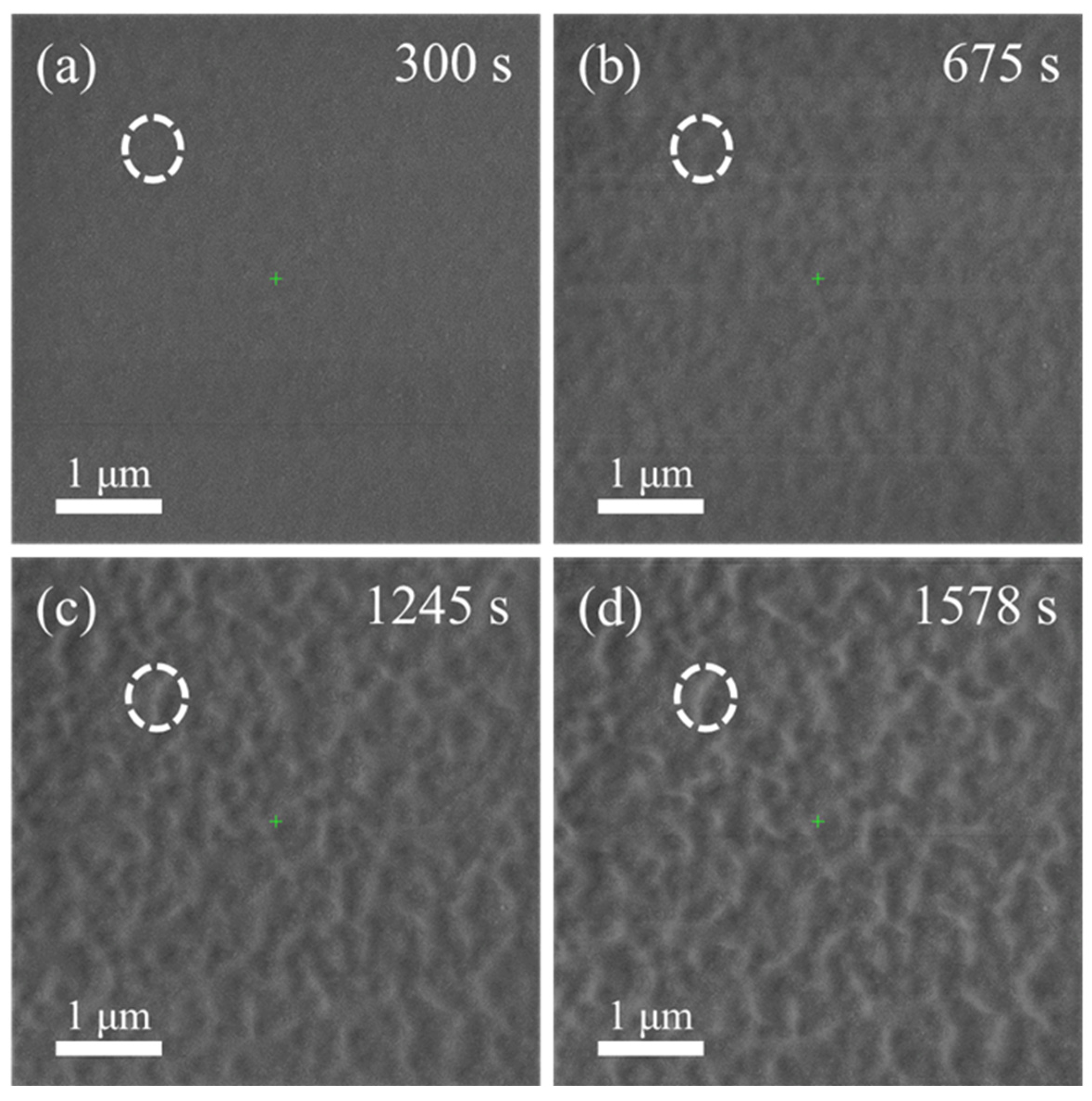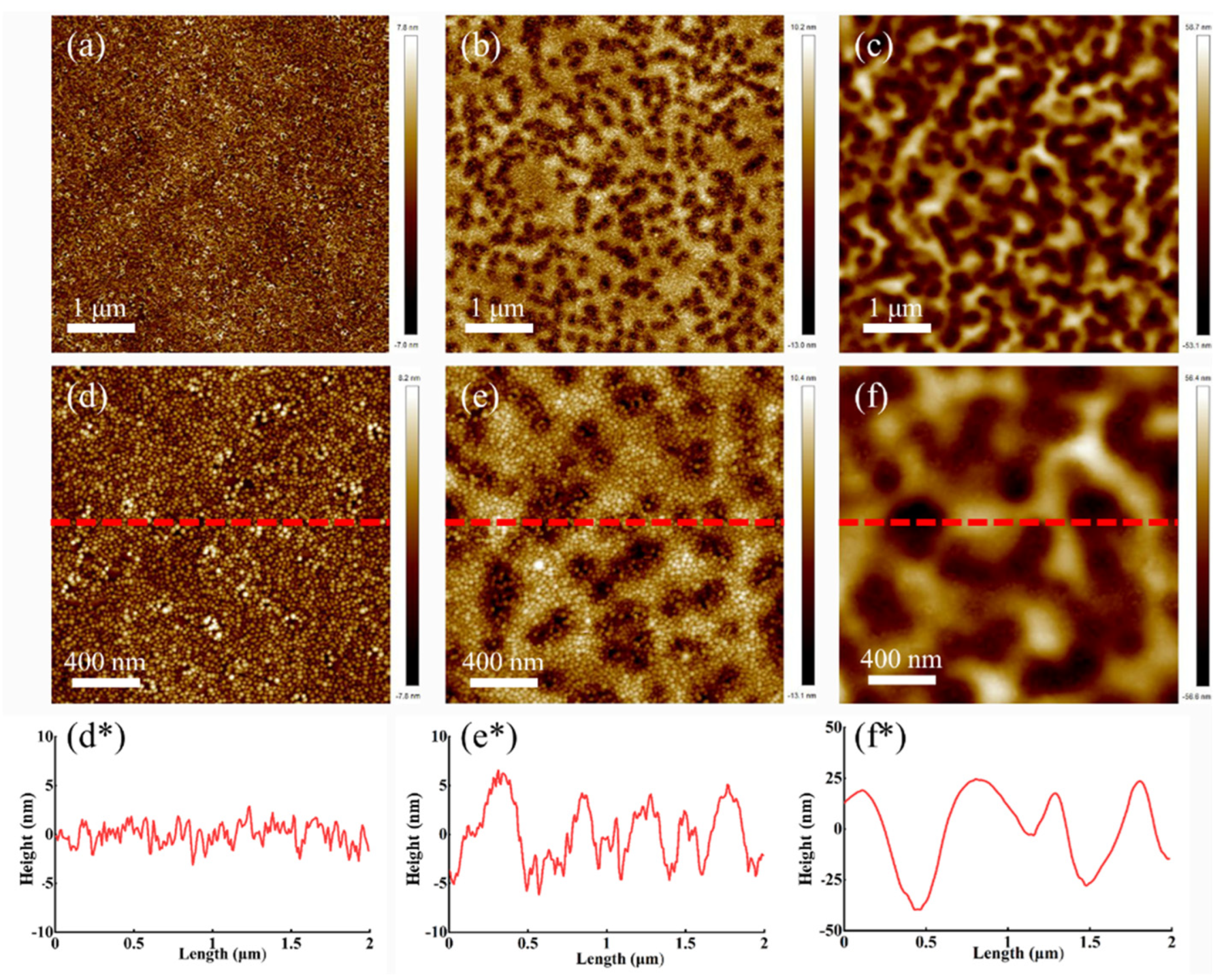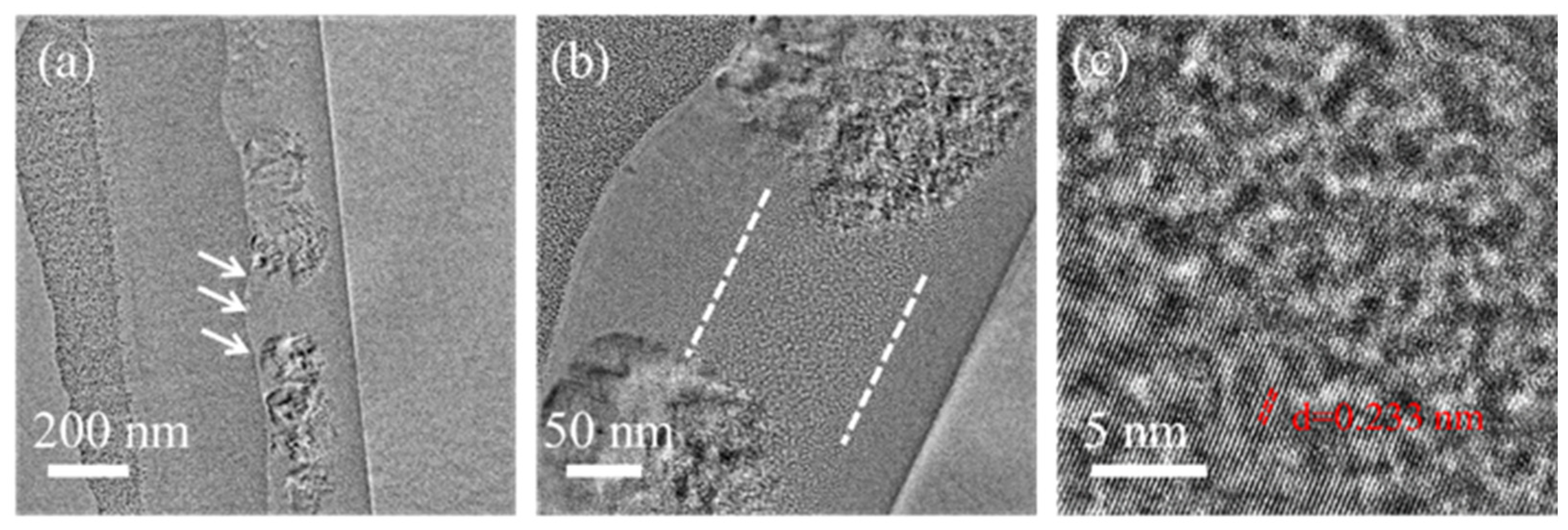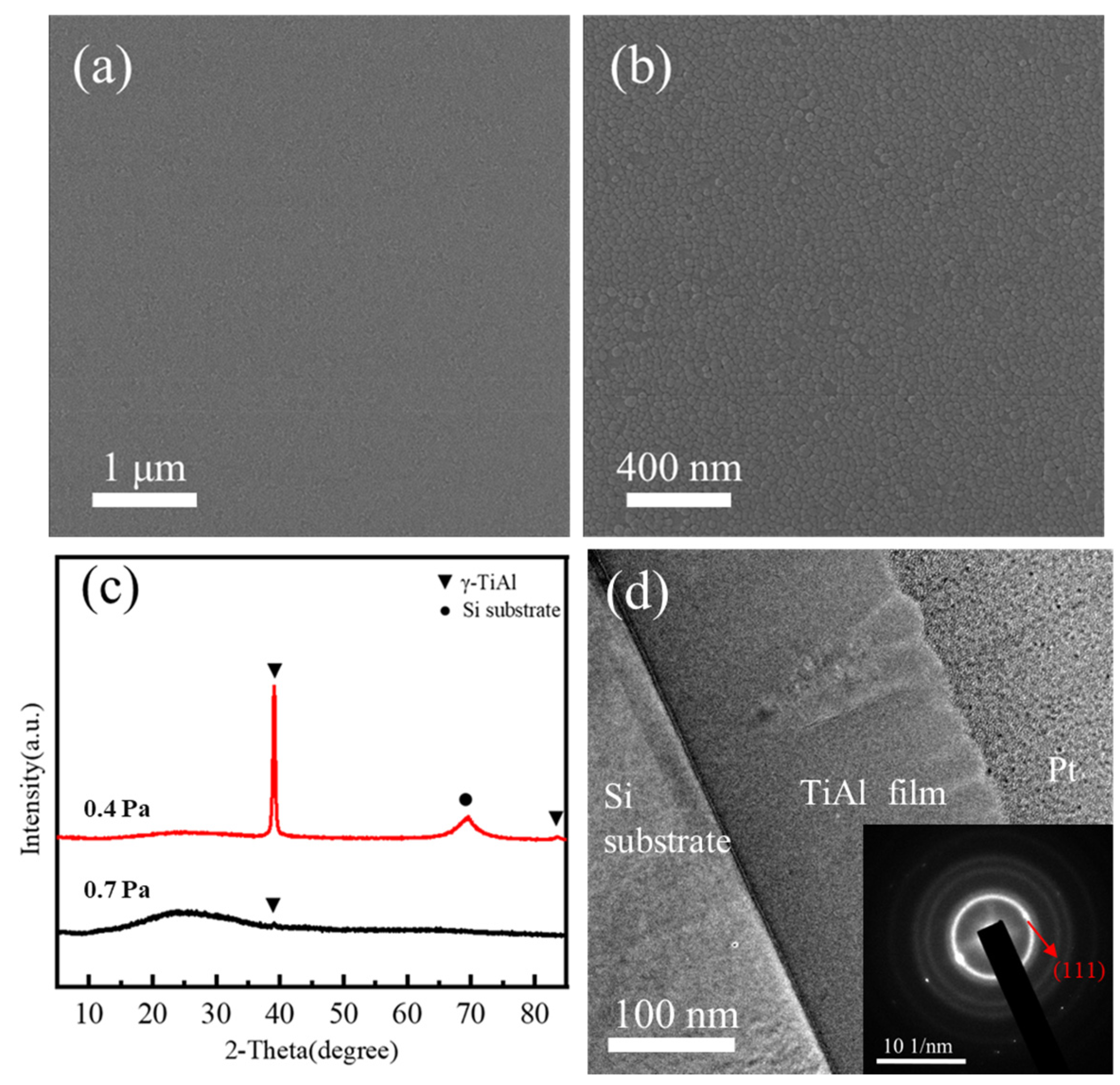Structure Evolution of Nanocrystalline–Amorphous TiAl Biphase Films during Helium Ion Implantation
Abstract
1. Introduction
2. Materials and Methods
2.1. TiAl Films Preparation
2.2. TiAl Films Characterization
2.3. Helium Implantation Experiment
3. Results and Discussion
3.1. Microstructure of TiAl Films
3.2. Helium Ion Implantation

- Helium ion implantation was conducted at room temperature on N–A TiAl film using a helium ion microscope. The entire implantation process lasted 1578 s and the final helium ion implantation fluence was 4 × 1017 ions cm−2. As shown in Figure 3a–d, the partial bulge phenomenon emerged on the TiAl film surface during implantation. As the implantation time increased, the partial bulge phenomenon became more evident; the location is marked with a white dotted line as an example. At 300 s, a slight surface bulge could be seen, indicating that partial swelling had occurred in the N–A TiAl film. At 675 s, the bulge area became more pronounced and could be easily observed. Notably, the emergence of each bulge area occurred nearly simultaneously throughout the entire implantation region, and the evolution of the structure was nearly identical as implantation time progressed. This indicates that the origin of these partial bulge areas was uniform and not a chance occurrence. The boundaries between the bulge and the remaining area became more visible at 1245 and 1578 s. Moreover, the partial bulge areas were interconnected with each other. The partial bulge phenomenon may have originated in the partial amorphous regions in the N–A TiAl film, which swelled upon helium implantation. When the implantation was finished, there were no blisters or cracks on the N–A TiAl film surface, suggesting better implantation tolerance than nanocrystalline TiAl films [11].

- To further investigate the structure evolution of the TiAl film, gradient helium ion implantation fluence experiments were performed on the adjacent areas of the same sample, and AFM was employed to characterize the surface structure of the implantation region. As illustrated in Figure 4a,d, a uniform arch-like surface structure could be seen, which was due to the enhancement of the sputtering and deposition rate at 0.7 Pa Ar pressure, resulting in low energy sputtering atoms; this is consistent with the results in Figure 1b. It decreased the critical nucleus size and nucleation force, giving rise to a fine fibrous morphology of approximately 20 nm in the structure. The Rq (the root mean square roughness, root mean square average of profile height deviations from the mean line) of the initial film was 2.12 nm, as shown in Table 1. In addition, the height map in Figure 4d* shows that the range of the sample surface height undulation was approximately 2 nm, indicating that the surface of the film was uniform and smooth. The surface structure of the TiAl film following 1 × 1017 ions cm−2 helium implantation fluence is shown in Figure 4b,e; slight bulges can be observed in partial areas, which has been rarely reported in previous studies. The appearance of these bulge areas led to an uneven film surface structure and an increase in the Rq value, up to 3.43 nm. From the height graph in Figure 4e* it can be seen that the height difference in bulging areas was approximately 10 nm. Furthermore, the arch-like surface structure of the N–A TiAl film was still evident in both the bulge areas and the surrounding areas, indicating that the alteration in the surface structure of the N–A TiAl film was not a result of exfoliation of the sample surface or thinning during the implantation process. It originated from the internal structural evolution of the film. Figure 4c,f show that the bulges on partial areas became more significant when the implantation fluence increased to 4 × 1017 ions cm−2. As can be seen from Figure 4f*, the bulge height reached approximately 50 nm. Table 1 shows the Rq of the implantation area with different helium ion fluences; the Rq increased rapidly with an increase in the implantation fluence, which was directly related to the continuous growth of the partial bulge structure.

| Implantation Fluence (×1017 Ions cm−2) | 0 | 1 | 2 | 3 | 4 |
|---|---|---|---|---|---|
| Rq (nm) | 2.12 | 3.43 | 8.30 | 13.9 | 18.5 |
- To explore the N–A TiAl film evolution process, the cross-sectional of the post-implanted film with a helium ion implantation fluence of 2 × 1017 ions cm−2 was observed with TEM. As shown in Figure 5a, swelling appeared on the partial area with a width of approximately 100 nm (the example is marked by arrows) compared to the initial N–A TiAl film image in Figure 1d, which was consistent with the HIM and AFM results. A typical amorphous structure was found beneath each of the swelling areas and the swelling height of the amorphous region was approximately 30 nm compared to the surrounding area. As shown in Figure 5b, the helium bubbles were distributed in bands at depths from 100 to 220 nm (the region marked with white dotted lines). Many small and irregular bubbles showed a light contrast, suggesting a low mass/atomic number density. The size of He-induced spherical bubbles was 2–3 nm, which was related to the production of He clusters. The bubbles decreased in diameter from the middle of the band to both sides, indicating that the bubble size was associated with the helium atoms’ concentration. This can be attributed to the isotropic and a large free volume of amorphous structure. Additionally, the presence of grains below each sunk region should be noted. When the grains were exposed to helium implantation, there were slight swelling phenomena (approximately 20 nm) in the grain region compared with the initial N–A TiAl film thickness. As shown in Figure 5c, the interplanar spacing of the grains increased to 0.233 nm, which was larger than the initial N–A TiAl film (0.231 nm, calculated via XRD and SAED). The expansion of interplanar spacing can be attributed to the formation of helium atoms or bubble structures in grains, resulting in a swelling of grains. It exhibited lighter swelling than the amorphous region because of the lattice structure within the grain.

- The above results indicate that the uneven surface structure observed in N–A TiAl films during helium ion implantation was due to the difference in swelling rates between the amorphous and grain regions. The low diffusion of helium atoms and the presence of excessive free volume in the amorphous regions resulted in a higher swelling rate compared to the grain regions at the same implantation fluence. With increasing implantation fluence, the concentration of helium atoms increased, leading to an increase in the volume occupied by helium bubbles and a persistent bulge in the amorphous regions. The rounded shape of the surface bulge, instead of a uniform swelling, could be attributed to the presence of grains around the amorphous regions during the swelling process, which led to an uneven distribution of helium atoms’ concentration in the same depth and resulted in a more pronounced rounded surface structure. On the other hand, the low swelling rate in grain regions could be attributed to the presence of lattice structures and the diffusion of helium atoms along (111) planes to the interface [30,31]. Additionally, the helium atoms inside the grain tended to diffuse to the interface because of the strong helium sinking effect of the amorphous–nanocrystalline interface. It reduced the concentration of helium atoms making it more difficult to reach the critical dose for blister and inhibited the emergence of larger plate structures inside the grain, delaying surface blistering and improving the irradiation resistance of the N–A TiAl film.
4. Conclusions
Author Contributions
Funding
Institutional Review Board Statement
Informed Consent Statement
Data Availability Statement
Conflicts of Interest
References
- Brook, B.W.; Alonso, A.; Meneley, D.A.; Misak, J.; Blees, T.; van Erp, J.B. Why nuclear energy is sustainable and has to be part of the energy mix. Sustain. Mater. Technol. 2014, 1–2, 8–16. [Google Scholar] [CrossRef]
- Zhou, S.; Zhang, X. Nuclear energy development in China: A study of opportunities and challenges. Energy 2010, 35, 4282–4288. [Google Scholar] [CrossRef]
- Mansur, L.K.; Rowcliffe, A.F.; Nanstad, R.K.; Zinkle, S.J.; Corwin, W.R.; Stoller, R.E. Materials needs for fusion, Generation IV fission reactors and spallation neutron sources—Similarities and differences. J. Nucl. Mater. 2004, 329–333, 166–172. [Google Scholar] [CrossRef]
- Grimes, R.W.; Konings, R.J.M.; Edwards, L. Greater tolerance for nuclear materials. Nat. Mater. 2008, 7, 683–685. [Google Scholar] [CrossRef] [PubMed]
- WAS, G.S. Fundamentals of Radiation Materials Science: Metals and Alloys; Springer: New York, NY, USA, 2016. [Google Scholar]
- Oliviero, E.; Beaufort, M.F.; Barbot, J.F. Dislocations induced by bubble formation in high energy He implantation in silicon. J. Appl. Phys. 2001, 89, 5332–5338. [Google Scholar] [CrossRef]
- Yang, Q.; Fan, H.; Ni, W.; Liu, L.; Berthold, T.; Benstetter, G.; Liu, D.; Wang, Y. Observation of interstitial loops in He + irradiated W by conductive atomic force microscopy. Acta Mater. 2015, 92, 178–188. [Google Scholar] [CrossRef]
- Fan, C.; Li, C.; Parish, C.M.; Katoh, Y.; Hu, X. Helium effects on the surface and subsurface evolutions in single-crystalline tungsten. Acta Mater. 2021, 203, 116420. [Google Scholar] [CrossRef]
- Yang, Q.; You, Y.-W.; Liu, L.; Fan, H.; Ni, W.; Liu, D.; Liu, C.S.; Benstetter, G.; Wang, Y. Nanostructured fuzz growth on tungsten under low-energy and high-flux He irradiation. Sci. Rep. 2015, 5, 10959. [Google Scholar] [CrossRef]
- Wang, W.; Roth, J.; Lindig, S.; Wu, C.H. Blister formation of tungsten due to ion bombardment. J. Nucl. Mater. 2001, 299, 124–131. [Google Scholar] [CrossRef]
- Liu, P.; Tian, L.; Li, X.; Ma, Y.; Xia, J.; Meng, X. Structural evolution of amorphous and nanocrystalline TiAl films under helium implantation. Surf. Coat. Technol. 2022, 441, 128523. [Google Scholar] [CrossRef]
- Tian, L.; Liu, P.; Li, X.; Ma, Y.; Meng, X. Cracks and blisters formed in nanocrystalline tungsten films by helium implantation. Fusion Eng. Des. 2021, 172, 112879. [Google Scholar] [CrossRef]
- Zinkle, S.J.; Busby, J.T. Structural materials for fission & fusion energy. Mater. Today 2009, 12, 12–19. [Google Scholar] [CrossRef]
- Zinkle, S.J.; Snead, L.L. Designing Radiation Resistance in Materials for Fusion Energy. Annu. Rev. Mater. Res. 2014, 44, 241–267. [Google Scholar] [CrossRef]
- Chen, H.; Hai, Y.; Zhan, X.; Liu, X.; Xu, J.; Yin, W. Nano-amorphous layers improve the helium swelling resistance of a CAC-type nanocomposite. J. Appl. Phys. 2021, 129, 185301. [Google Scholar] [CrossRef]
- Su, Q.; Price, L.; Colon Santana, J.A.; Shao, L.; Nastasi, M. Irradiation tolerance of amorphous SiOC/crystalline Fe composite. Mater. Lett. 2015, 155, 138–141. [Google Scholar] [CrossRef]
- Ludy, J.E.; Rupert, T.J. Amorphous intergranular films act as ultra-efficient point defect sinks during collision cascades. Scr. Mater. 2016, 110, 37–40. [Google Scholar] [CrossRef]
- Schuler, J.D.; Grigorian, C.M.; Barr, C.M.; Boyce, B.L.; Hattar, K.; Rupert, T.J. Amorphous intergranular films mitigate radiation damage in nanocrystalline Cu-Zr. Acta Mater. 2020, 186, 341–354. [Google Scholar] [CrossRef]
- Neelav, A.H.; Pal, S.; Deng, C. Atomistic investigation of the deformation mechanisms in nanocrystalline Cu with amorphous intergranular films. J. Appl. Phys. 2019, 126, 125101. [Google Scholar] [CrossRef]
- Xia, Q.; Ren, P.; Meng, H. High performance of amorphous nanocrystalline composite structure materials. J. Mater. Res. Technol. 2022, 18, 4479–4485. [Google Scholar] [CrossRef]
- Khalajhedayati, A.; Pan, Z.; Rupert, T.J. Manipulating the interfacial structure of nanomaterials to achieve a unique combination of strength and ductility. Nat. Commun. 2016, 7, 10802. [Google Scholar] [CrossRef]
- Zhang, Y.; Chen, J.; Sun, G.; Huang, H.; Tong, L.; Wang, M.; Li, H.; He, X.; He, X.; Zhang, K.; et al. Strain rate-dependent hardness and deformation behavior in the nanocrystalline/amorphous Ti2AlNb film. Surf. Coat. Technol. 2021, 412, 127040. [Google Scholar] [CrossRef]
- Hishinuma, A.; Fukai, K.; Sawai, T.; Nakata, K. Ductilization of TiAl intermetallic alloys by neutron-irradiation. Intermetallics 1996, 4, 179–184. [Google Scholar] [CrossRef]
- Kondo, T.; Watanabe, Y.; Yi, Y.S.; Hishinuma, A. An evaluation of potential material–coolant compatibility for applications in advanced fusion reactors. J. Nucl. Mater. 1998, 258–263, 2083–2087. [Google Scholar] [CrossRef]
- Seki, Y.; Tabara, T.; Aoki, I.; Ueda, S.; Nishio, S.; Kurihara, R. Impact of low activation materials on fusion reactor design. J. Nucl. Mater. 1998, 258–263, 1791–1797. [Google Scholar] [CrossRef]
- Shepherd, D. Technology readliness level (TRL) assessment of cladding alloys for advanced nuclear fuels. In Proceedings of the Structural Materials for Innovative Nuclear Systems (SMINS-3), Nuclear Energy Agency Organisation for Economic Co-Operation and Development, Idaho Falls, ID, USA, 3 April 2015; pp. 108–116. [Google Scholar] [CrossRef]
- Thornton, J.A. Influence of apparatus geometry and deposition conditions on the structure and topography of thick sputtered coatings. J. Vac. Sci. Technol. 1974, 11, 666–670. [Google Scholar] [CrossRef]
- Ziegler, J.F. SRIM-2003. Nucl. Instrum. Methods Phys. Res. Sect. B Beam Interact. Mater. At. 2004, 219–220, 1027–1036. [Google Scholar] [CrossRef]
- Ziegler, J.F.; Ziegler, M.D.; Biersack, J.P. SRIM—The stopping and range of ions in matter. Nucl. Instrum. Methods Phys. Res. Sect. B Beam Interact. Mater. At. 2010, 268, 1818–1823. [Google Scholar] [CrossRef]
- Cao, Y.; Li, H.; Szpunar, J.A.; Shmayda, W.T. Effects of textures on hydrogen diffusion in nickel. Mater. Sci. Forum. 2002, 408–412, 1139–1144. [Google Scholar] [CrossRef]
- Mohammadzadeh, R.; Mohammadzadeh, M. Texture dependence of hydrogen diffusion in nanocrystalline nickel by atomistic simulations. Int. J. Hydrogen Energy 2018, 43, 7117–7127. [Google Scholar] [CrossRef]

Disclaimer/Publisher’s Note: The statements, opinions and data contained in all publications are solely those of the individual author(s) and contributor(s) and not of MDPI and/or the editor(s). MDPI and/or the editor(s) disclaim responsibility for any injury to people or property resulting from any ideas, methods, instructions or products referred to in the content. |
© 2023 by the authors. Licensee MDPI, Basel, Switzerland. This article is an open access article distributed under the terms and conditions of the Creative Commons Attribution (CC BY) license (https://creativecommons.org/licenses/by/4.0/).
Share and Cite
Liu, P.; Tian, L.; Li, X.; Cao, J.; Ma, Y.; Meng, X. Structure Evolution of Nanocrystalline–Amorphous TiAl Biphase Films during Helium Ion Implantation. Coatings 2023, 13, 632. https://doi.org/10.3390/coatings13030632
Liu P, Tian L, Li X, Cao J, Ma Y, Meng X. Structure Evolution of Nanocrystalline–Amorphous TiAl Biphase Films during Helium Ion Implantation. Coatings. 2023; 13(3):632. https://doi.org/10.3390/coatings13030632
Chicago/Turabian StyleLiu, Pei, Lifeng Tian, Xuanze Li, Jianyu Cao, Yutian Ma, and Xiangmin Meng. 2023. "Structure Evolution of Nanocrystalline–Amorphous TiAl Biphase Films during Helium Ion Implantation" Coatings 13, no. 3: 632. https://doi.org/10.3390/coatings13030632
APA StyleLiu, P., Tian, L., Li, X., Cao, J., Ma, Y., & Meng, X. (2023). Structure Evolution of Nanocrystalline–Amorphous TiAl Biphase Films during Helium Ion Implantation. Coatings, 13(3), 632. https://doi.org/10.3390/coatings13030632






